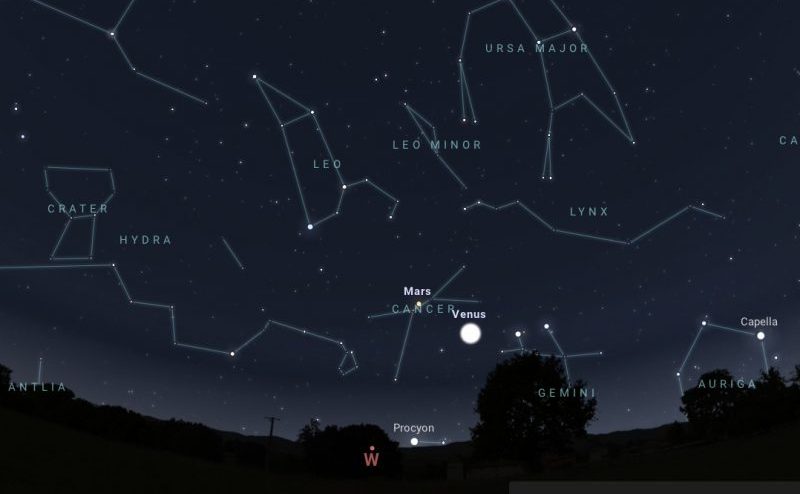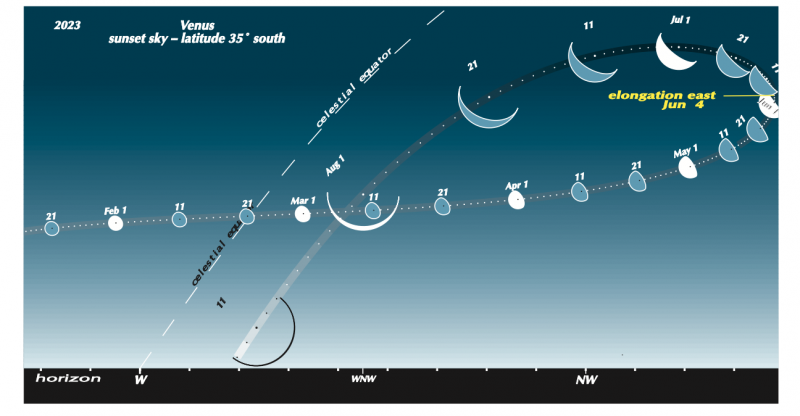
When to watch: Venus came into view after sunset in December 2022 and has been visible in the evening sky throughout the first half of 2023. Greatest elongation – when Venus will be farthest from the sunset – happens on June 4, 2023. Afterwards, Venus will quickly sink toward the sunset as it races toward its sweep between the Earth and sun around mid-August 2023.
Where to look: Look in the sunset direction while the sky is darkening. You can’t miss Venus as the dazzling evening “star.”
Greatest elongation is at 11 UTC on June 4. That’s a whole-Earth time … for all of us, Venus will still appear in our evening sky, in the west after sunset. At this elongation, the distance of Venus from the sun on the sky’s dome is 46 degrees.
Magnitude at greatest elongation: Venus shines at magnitude -4.4.
Through a telescope: Venus appears 49% illuminated, in a first quarter phase, 23.56 arcseconds across.
Note: As the sun’s 2nd planet, Venus is bound by an invisible tether to the sun in our sky. It’s always east before sunrise, or west after sunset (never overhead at midnight). Venus is the brightest planet visible from Earth and shines brilliantly throughout every morning or evening apparition. Greatest elongation happens when Venus is farthest from the sun on the sky’s dome.
For precise sun and Venus rising times at your location:
Old Farmer’s Almanac (U.S. and Canada)
timeanddate.com (worldwide)
Stellarium (free online planetarium program)
Venus after sunset in 2023 Northern Hemisphere

Venus after sunset in 2023 Southern Hemisphere

A comparison of elongations
Not all of Venus’s greatest elongations are created equal. That’s because the farthest from the sun that Venus can ever appear on the sky’s dome is about 47.3 degrees. On the other hand, the least distance is around 45.4 degrees.
Elongations are also higher or lower depending on the time of year they occur and your location on Earth.

Venus events from late 2022 into 2024
October 22, 2022: Superior conjunction (passes behind sun from Earth)
June 4, 2023: Greatest elongation (evening)
August 13, 2023: Inferior conjunction (races between Earth and sun)
October 23, 2023: Greatest elongation (morning)
June 4, 2024: Superior conjunction (passes behind sun from Earth)
Bottom line: At greatest eastern elongation on June 4, 2023, Venus is as far from the sunset as it will be for this evening apparition.
The post Venus after sunset: Greatest elongation on June 4, 2023 first appeared on EarthSky.
from EarthSky https://ift.tt/7rlon2Y

When to watch: Venus came into view after sunset in December 2022 and has been visible in the evening sky throughout the first half of 2023. Greatest elongation – when Venus will be farthest from the sunset – happens on June 4, 2023. Afterwards, Venus will quickly sink toward the sunset as it races toward its sweep between the Earth and sun around mid-August 2023.
Where to look: Look in the sunset direction while the sky is darkening. You can’t miss Venus as the dazzling evening “star.”
Greatest elongation is at 11 UTC on June 4. That’s a whole-Earth time … for all of us, Venus will still appear in our evening sky, in the west after sunset. At this elongation, the distance of Venus from the sun on the sky’s dome is 46 degrees.
Magnitude at greatest elongation: Venus shines at magnitude -4.4.
Through a telescope: Venus appears 49% illuminated, in a first quarter phase, 23.56 arcseconds across.
Note: As the sun’s 2nd planet, Venus is bound by an invisible tether to the sun in our sky. It’s always east before sunrise, or west after sunset (never overhead at midnight). Venus is the brightest planet visible from Earth and shines brilliantly throughout every morning or evening apparition. Greatest elongation happens when Venus is farthest from the sun on the sky’s dome.
For precise sun and Venus rising times at your location:
Old Farmer’s Almanac (U.S. and Canada)
timeanddate.com (worldwide)
Stellarium (free online planetarium program)
Venus after sunset in 2023 Northern Hemisphere

Venus after sunset in 2023 Southern Hemisphere

A comparison of elongations
Not all of Venus’s greatest elongations are created equal. That’s because the farthest from the sun that Venus can ever appear on the sky’s dome is about 47.3 degrees. On the other hand, the least distance is around 45.4 degrees.
Elongations are also higher or lower depending on the time of year they occur and your location on Earth.

Venus events from late 2022 into 2024
October 22, 2022: Superior conjunction (passes behind sun from Earth)
June 4, 2023: Greatest elongation (evening)
August 13, 2023: Inferior conjunction (races between Earth and sun)
October 23, 2023: Greatest elongation (morning)
June 4, 2024: Superior conjunction (passes behind sun from Earth)
Bottom line: At greatest eastern elongation on June 4, 2023, Venus is as far from the sunset as it will be for this evening apparition.
The post Venus after sunset: Greatest elongation on June 4, 2023 first appeared on EarthSky.
from EarthSky https://ift.tt/7rlon2Y

Aucun commentaire:
Enregistrer un commentaire